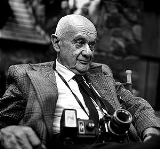
and Eastern Europe
before the Holocaust
. A complete archive of his work now rests at the International Center of Photography
.
Vishniac was an extremely diverse photographer, an accomplished biologist
and a knowledgeable collector and teacher of art history
. Throughout his life, he made significant scientific contributions to photomicroscopy
and time-lapse photography
.
Even before the concentration camps, I felt it was my duty to my ancestors to preserve a world which might cease to exist.![]()
Concentration camp money... It was a German sadism that invented it. Can you do anything with it? Yes, you can cry.![]()
The Jews of the shtetls that Tolstoy remembered were saints... the people I photographed were saints. So now, in 1983, I tell the world: When you learn about Goethe, don't forget to study the Holocaust, too.![]()
...can you call a farm with a dozen geese a farm? Still, it was a little better for the Jews in Czechoslovakia. There were only two pogroms there. What's two pogroms?![]()
Nature, God, or whatever you want to call the creator of the universe comes through the microscope clearly and strongly![]()
The purpose of photography is the transmission of a visualized sector of life through the medium of the camera into a mental process that starts with the photographer's thinking about the subject he photographs and is continued in the mind of the spectator.![]()
You can't teach biology with a bottle containing dead animals and organisms.![]()
[his scientific accomplishments] were overshadowed by the photographs he took of Jews in prewar Eastern Europe and in Nazi Berlin. -- Shepard, Richard![]()

